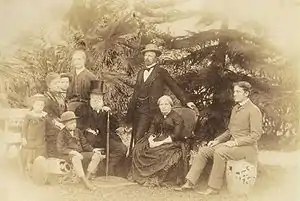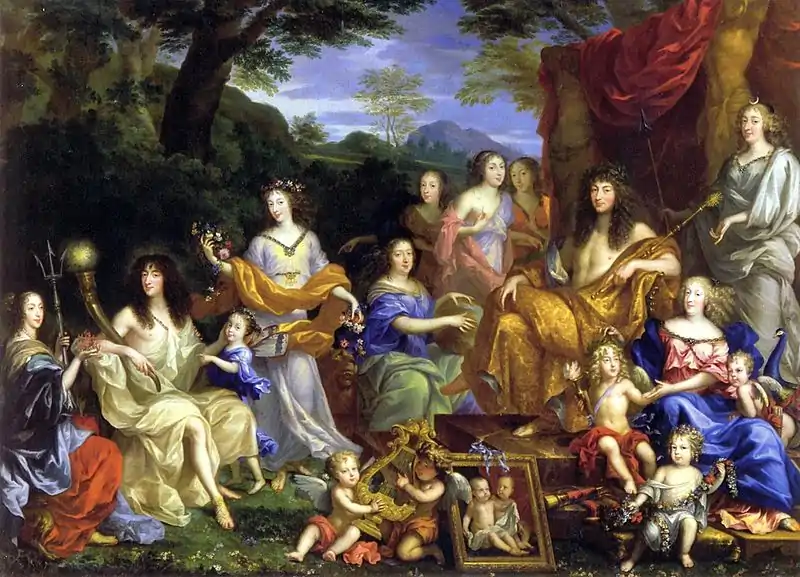| Part of the Politics series |
| Monarchy |
|---|
.svg.png.webp) |
|
|
A royal family is the immediate family of kings/queens, emirs/emiras, sultans/sultanas, or raja/rani and sometimes their extended family.
The term imperial family appropriately describes the family of an emperor or empress, and the term papal family describes the family of a pope, while the terms baronial family, comital family, ducal family, archducal family, grand ducal family, or princely family are more appropriate to describe, respectively, the relatives of a reigning baron, count/earl, duke, archduke, grand duke, or prince.
However, in common parlance members of any family which reigns by hereditary right are often referred to as royalty or "royals". It is also customary in some circles to refer to the extended relations of a deposed monarch and their descendants as a royal family. A dynasty is sometimes referred to as the "House of ...". In July 2013 there were 26 active sovereign dynasties in the world that ruled or reigned over 43 monarchies.[1]
As of 2021, while there are several European countries whose nominal head of state, by long tradition, is a king or queen, the associated royal families, with the notable exception of the British royal family, are non-notable ordinary citizens who may bear a title but are not involved in public affairs.[2]
Members of a royal family
A royal family typically includes the spouse of the reigning monarch, surviving spouses of a deceased monarch, the children, grandchildren, brothers, sisters, and paternal cousins of the reigning monarch, as well as their spouses. In some cases, royal family membership may extend to great grandchildren and more distant descendants of a monarch. In certain monarchies where voluntary abdication is the norm, such as the Netherlands, a royal family may also include one or more former monarchs. In certain instances, such as in Canada, the royal family is defined by who holds the styles Majesty and Royal Highness.[3] There is often a distinction between persons of the blood royal and those that marry into the royal family. Under most systems, only persons in the first category are dynasts, that is, potential successors to the throne (unless the member of the latter category is also in line to the throne in their own right, a frequent occurrence in royal families which frequently intermarry). This is not always observed; some monarchies have operated by the principle of jure uxoris.
In addition, certain relatives of the monarch (by blood or marriage) possess special privileges and are subject to certain statutes, conventions, or special common law. The precise functions of a royal family vary depending on whether the polity in question is an absolute monarchy, a constitutional monarchy, or somewhere in between. In certain monarchies, such as that found in Saudi Arabia or Kuwait, or in political systems where the monarch actually exercises executive power, such as in Jordan, it is not uncommon for the members of a royal family to hold important government posts or military commands. In most constitutional monarchies, however, members of a royal family perform certain public, social, or ceremonial functions, but refrain from any involvement in electoral politics or the actual governance of the country.
The specific composition of royal families varies from country to country, as do the titles and royal and noble styles held by members of the family. The composition of the royal family may be regulated by statute enacted by the legislature (e.g., Spain, the Netherlands, and Japan since 1947), the sovereign's prerogative and common law tradition (e.g., the United Kingdom), or a private house law (e.g., Liechtenstein, the former ruling houses of Bavaria, Prussia, Hanover, etc.). Public statutes, constitutional provisions, or conventions may also regulate the marriages, names, and personal titles of royal family members. The members of a royal family may or may not have a surname or dynastic name (see Royal House).
In a constitutional monarchy, when the monarch dies, there is always a law or tradition of succession to the throne that either specifies a formula for identifying the precise order of succession among family members in line to the throne or specifies a process by which a family member is chosen to inherit the crown. Usually in the former case the exact line of hereditary succession among royal individuals may be identified at any given moment during prior reigns (e.g. United Kingdom, Sark, Nizari Ismailis, Japan, Balobedus, Sweden, Kingdom of Benin) whereas in the latter case the next sovereign may be selected (or changed) only during the reign or shortly after the demise of the immediately preceding monarch (e.g. Cambodia, KwaZulu Natal, Buganda, Saudi Arabia, Swaziland, Yorubaland, The Kingitanga). Some monarchies employ a mix of these selection processes (Malaysia, Monaco, Tonga, Jordan, Morocco), providing for both an identifiable line of succession as well as authority for the monarch, dynasty or other institution to alter the line in specific instances without changing the general law of succession.
Some countries have abolished royalty altogether, as in post-revolutionary France (1870), post-revolutionary Russia (1917), Portugal (1910), post-war Germany (1918), post-war Italy (1946) and many ex European colonies.
Current royal families
| Part of a series on |
| Imperial, royal, noble, gentry and chivalric ranks in West, Central, South Asia and North Africa |
|---|
.svg.png.webp) |
|
Africa
Middle East
Asia
Europe
Oceania
North America
Deposed royal families
Africa
- Central African imperial family
- Egyptian royal family
- Ethiopian imperial family
- Gambian royal family
- Ghanaian royal family
- Kenyan royal family
- Libyan royal family
- Malawian royal family
- Mauritian royal family
- Nigerian royal family
- Rwandan royal family
- Rhodesian (Zimbabwean) royal family
- Sierra Leonean royal family
- South African royal family
- Tanganykan (Tanzanian) royal family
- Tunisian royal family
- Ugandan royal family
- Umurundi royal family
Middle East
Asia
- Afghan royal family
- Bengali royal family
- Burmese royal family
- Ceylonese (Sri Lankan) royal family
- Chinese imperial family
- Indian imperial family
- Baroda royal family
- Royal family of Dhaka
- Jodhpur royal family
- Mysore roya Family (Wadiyar dynasty)
- Korean imperial family
- Laotian royal family
- Maldivian sultanic family
- Nepalese royal family
- Pakistani royal family
- Singaporean sultanic family
- Uzbek royal families
- Vietnamese imperial family
Europe
- Albanian royal family
- Austrian imperial family
- Bohemian (Czech) royal family
- Bulgarian royal family
- Croatian royal family
- Finnish royal family
- French imperial family
- Georgian royal family
- German imperial family
- Greek royal family
- Irish royal family
- Italian royal family
- Hungarian royal family
- Lithuanian royal family
- Maltese royal family
- Montenegrin royal family
- Polish royal family (Congress Poland)
- Portuguese royal family
- Romanian royal family
- Russian imperial family
- Serbian royal family
Oceania
North America
South America

Mediatised princely families
Whilst mediatization occurred in other countries such as France, Italy and Russia, only the certain houses within the former Holy Roman Empire are collectively called the Mediatized Houses.
Dynasties
- House of Asturias-Cantabria
- Aberffraw House of Gwynedd
- Al-Abbasi
- Al Khalifa
- Al-Sabah
- Al-Falasi
- Al Ghardaqa
- Uyunid dynasty
- Alaouite dynasty
- Angevin dynasties
- Artaxiad dynasty
- Arsacid dynasty
- Artsruni dynasty
- Sassanid dynasty
- House of Árpád
- House of Arslan (The Lakhmids)
- House of Aviz
- House of Bernadotte
- House of Bagrat
- Balti dynasty
- House of Blois
- House of Bonaparte
- Borjigid
- House of Bourbon
- House of Bokassa
- House of Orléans
- House of Bourbon-Parma
- House of Orléans-Braganza
- House of Braganza
- House of Capet
- Carolingian dynasty
- House of Coimbra
- Chakri dynasty (House of Mahidol)
- Dynasties of China
- Comnenian dynasty
- Cochin royal family
- Davidic line
- House of Dlamini
- Flavian dynasty
- Gediminids
- Ghassanids
- Giray dynasty
- House of Grimaldi
- House of Glücksburg
- House of Habsburg
- Rubenid dynasty
- Hethumid dynasty
- House of Hamengkubuwono
- House of Hanover
- Hashemite
- Hasmonean
- House of Hesse
- House of Hohenzollern
- Holstein-Gottorp-Romanov
- Dynasties of India
- Jagiellons
- Julio-Claudian dynasty
- House of Karađorđević
- Keita Dynasty
- Khun Lo dynasty
- Banū Khuzaʽah
- Hawaiian houses
- Irish houses
- Dynasties of Korea
- Unified Silla
- Goryeo dynasty
- Joseon dynasty (House of Yi)
- House of Lancaster
- House of Lusignan
- Merovingian dynasty
- Nayaks of Kandy
- House of Nemanjić
- Muhammad Ali dynasty
- Nigerian houses
- House of Normandy
- House of Obrenović
- House of Oldenburg
- Omrides
- House of Holstein-Gottorp
- House of Orange-Nassau
- House of Pakubuwono
- Ottoman dynasty
- Pahlavi dynasty
- Piast dynasty
- House of Plantagenet
- Přemyslid dynasty
- Qajar dynasty
- Timurid dynasty
- Romanov (Holstein-Gottorp-und-Romanov)
- Rurik dynasty
- Safavid dynasty
- House of Saud (Saudis)
- House of Savoy
- House of Saxe-Coburg and Gotha
- Solomonic dynasty
- House of Stuart
- House of Trastámara
- Travancore royal family
- Trần dynasty
- House of Tudor
- Uí Ímair
- Uí Néill
- House of Vasa
- House of Windsor
- House of Wittelsbach
- House of York
- Yax Kuk Mo Dynasty
- Zand dynasty
- House of Zogu
- House of Zhao
- House of Zhu
- The Senegambia (Senegal and the Gambia)
See also
- Abolished monarchy
- Babu (title)
- Born in the purple
- Chief of the Name
- Crown prince
- Divine right of kings
- Dynasty
- First Family (in some republican states)
- Family trees of royal families
- Nobility
- Palace
- Prince
- Prince consort
- Princeps
- Princess
- Rai (title)
- Raja
- Rana (title)
- Rani (disambiguation)
- Princess Royal
- Queen consort
- Regicide
- Royal and noble styles
- Royal descent
- Rao (Indian surname)
- Royal prerogative
References
- ↑ Meet the world's other 25 royal families
- ↑ Jenkins, Simon (13 March 2021). "Britain's royal family is an accident waiting to happen. Prince Charles should dismantle it". The Guardian.
- ↑ "Department of National Defence: The Honours, Flags and Heritage Structure of the Canadian Forces; pg 281" (PDF). Archived from the original (PDF) on 2009-03-25. Retrieved 2007-06-26.
External links
 Media related to Royal families at Wikimedia Commons
Media related to Royal families at Wikimedia Commons
